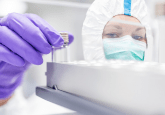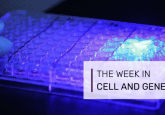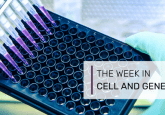Sustainability in pharma: an interview with Joel Eichmann

Joel Eichmann is a life scientist with a background in bioprocess engineering, manufacturing and synthetic biology. Before founding Green Elephant Biotech (Giessen, Germany), he worked several years in the pharmaceutical industry in vaccine manufacturing and tech transfer projects.
biology. Before founding Green Elephant Biotech (Giessen, Germany), he worked several years in the pharmaceutical industry in vaccine manufacturing and tech transfer projects.
Now at Green Elephant Biotech, he leads the development of new products and acts as a link between business development and research and development. He is passionate about building a greener future of the pharmaceutical industry and helping manufacturers and researchers reduce their environmental impact.
In this interview with Joel Eichmann at the Phacilitate conference (31 August–1 September 2022, London, UK), Joel shares his insights on sustainability in the pharmaceutical industry, drawing on his experience of co-founding Green Elephant Biotech (Giessen, Germany). To learn about why sustainability in the cell and gene therapy industry is gaining momentum, how the CellScrew product at Green Elephant Biotech could offer innovative solutions and more, make sure to catch the interview below.
Please could you introduce yourself and your company?
My name is Joel Eichmann and I’m one of the founders of Green Elephant Biotech. I have a background in biology bioprocess engineering and have been working for a vaccine manufacturer for a couple of years in tech-transfer projects. At Green Elephant Biotech, we make consumables and bioreactors for different applications with a strong focus on cultural devices currently. The main aim of the company is to decarbonize the pharma and biotech industries because we’re utilizing a lot of single-use plastic in these industries. Indeed, there are new materials that are much more sustainable than the plastics we currently have; there are quite a number of innovative materials that are plant-based instead of the crude oil-based materials we typically utilize. This is why we started trying to solve technical and environmental problems with solutions at Green Elephant Biotech.
How did you decide to focus on sustainability within cell and gene therapy and how did Green Elephant Biotech come about as a result?
I think the focus on saving patients and getting drugs rapidly to patients without considering sustainability may generationally vary within the pharmaceutical industry. We’re still seeing lots of movements rising that focus on sustainability everywhere in the world and especially in Europe and Germany. For example, with Fridays For Futures (Stockholm, Sweden), which is a big climate movement where younger people, who have been growing up with learning about climate change and the impacts it’s going to have on us and our children, are very involved.
Whereas, if I talk about climate change with my parents, I can see that their attitude is different because it likely will not affect them directly. By contrast, if I talk to my younger brother and if I think about my kids, we know climate change is really going to affect us within our lifetimes, so we have much more awareness of climate change. If we look into our professional spheres, we can see that we are utilizing huge amounts of single-use plastic and then we don’t even recycle it – we just burn it. I think that’s the point about plastic waste in the lab; it’s actually not a plastic waste problem, it’s a carbon emission problem because the plastic waste is burned because people don’t want to recycle it. There are also some technical issues surrounding recycling lab waste, plus some recycling companies don’t really want to deal with medical waste or waste generally because it has contaminated – for example, with genetically modified organisms or infectious materials, etc. As such, even if the material could be recycled from a technical perspective, no one wants. No one wants that waste.
Could you please tell me a bit more about your product and how it solves the challenges you describe?
In June, we launched our first product – the CellScrew. It’s a bioreactor for adherent cells, which are cells that only grow on surfaces. Currently, adherent cells are mostly cultivated, either in roller bottles, which are quite small and difficult to scale, or in stacked systems, like the cell factories. These cultivation technologies have a large growth area but they don’t include a process of mixing, meaning that oxygen transfer can be quite low. This means you cannot grow all cell lines in these devices. In addition, they are very large and difficult to automate.
The basic idea we had at Green Elephant Biotech was to utilize the concept of a roller bottle and put in two structures. The first is an Archimedean screw, which you may be familiar with from water parks, where you’re rotated and water is flowing against gravity. So this is utilized as the core structure in our roller bottle. And in the middle, there is a tube, so the bottle is lying with a slight slope and the media is transferred through the bottle and flows back to achieve a circularization of the media movement in that bottle. Additionally, around that central tube, there are concentric cylinders that make up a huge growth area, which makes the device very easy to handle and produces a very compact design. As a result, it is appropriate for everyone who does cell culture to bring to industrial scale manufacturing.
Our device is fully 3D-printed. At the beginning of our process, we started screening for materials that are appropriate for cell culture – cells need something they can grow on and the material needs to be biocompatible. Additionally, the material needs to meet all the regulatory requirements and be suitable for 3D printing. In the end, we came up with polylactic acid (PLA), which is utilized in exactly two areas of 3D printing – prototyping, because it’s so easy to utilize, and medical devices. Therefore, we found a material where you can easily set up a supply chain that meets the regulatory requirements and is also very biocompatible. For example, people make implants from PLA that are then slowly degraded in the body over the years.
Additionally, the nice thing about the PLA is that it’s derived from cornstarch, a plant-based material. Thinking about the carbon, the plant takes carbon from the atmosphere to build up the starch, which is then fermented to lactic acid and then synthesized into polylactic acid. This is how we came to utilize a plant-based approach for lab consumables. The other key point on how we achieve greater sustainability is through the 3D printing process, where we create much finer walls and structures and utilize less plastic to make the growth area – in fact, we utilize 90% less plastic than traditional methods and can save about 90% on carbon emissions.
How do you deal with the issue of contamination in the CellScrew structure?
This device is 3D-printed, cleaned and then gamma irradiated so it’s sterile and ready to utilize when you when you purchase it.
Was it difficult to get the company started?
The company was founded in December 2021, so we’re not even one year old yet. However, we had about four years of development, during which I was doing my PhD and then transitioned into an industry job and my co-founder was working in consulting. It was quite tough to get some funding initially. They wanted to see some real data and it’s not so easy to run a lab or do lab experiments while having a full-time job in the industry, which is why it took us some time to go from the basic idea and the patent application to actually receiving some funding. Progress has certainly accelerated since we’ve been able to dedicate ourselves to Green Elephant Biotech full-time.
How successful has the CellScrew product been in the industry thus far?
We’ve just sent the first items to our early adopters and we have had traction from the three biotech fields. First, from academia, where people are often keen to try new technologies and compare it to the status quo. Second, we have the field of biotech pharma, where we have some interest from startups but also big companies. Third, and something that was quite surprising for us, is that we have had a lot of traction from the cultivation foods industry.
Are you utilizing practices from other sectors to gain ideas on how to apply sustainability to the pharmaceutical industry?
We attend a lot of sustainability-related events and conferences, where we connect with lots of people that are involved in sustainability in various industries form a community. However, it’s quite interesting that the current paradigm of sustainability has changed a lot in the pharmaceutical industry, especially in the last couple of years. When we started around four years ago and were talking to the first big pharma companies, they really liked the technology but told us that we were 10 years ahead and that no one would buy the product just for the sake of sustainability. This has changed in the last couple of years. We’re not really sure why plastic waste and climate change have gained more public and political interest but the industry is changing from the inside and corporate companies are now setting very ambitious environmental goals. Therefore, this is good timing for us to launch our sustainable product.
Where would you like to see sustainability in the industry in five years’ time?
The nice thing is that this is an industry with a lot of potential for improving sustainability. Even if you have done nothing for sustainability in the last 20 years, it’s easy to catch up by just doing everything that everyone else has been doing for the last 20 years. This applies not only to plastic waste, but also renewable energies, gas consumption, heat consumption and water consumption, which is a huge topic. It will also be important to think about what the end of the lifecycle of my products. Overall, what I would like to see is people generating data during lifecycle assessments and then reducing waste and energy consumption wherever possible. I would like to see this industry really taking the topic of sustainability seriously and – beyond that – integrate it into their DNA.
You might also like:
- 3 ways to improve sustainability in advanced therapies
- In Focus: sustainability in cell and gene therapy
Disclaimer
The opinions expressed in this interview are those of the interviewee and do not necessarily reflect the views of RegMedNet or Future Science Group.





